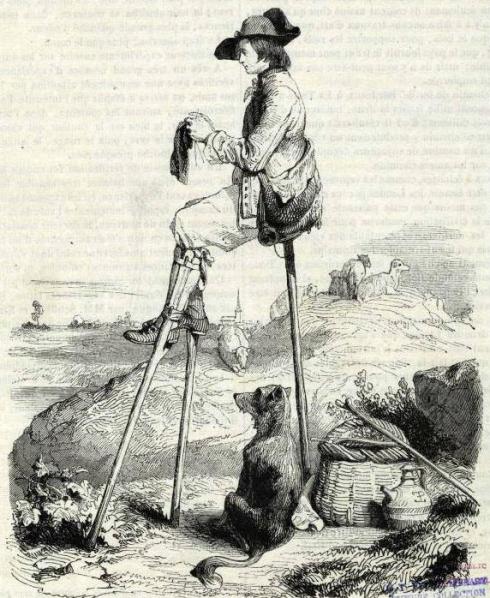I have been pondering several nineteenth-century prints, paintings and photographs of people walking around on stilts in the Landes region of Gascony (now Aquitaine) in France: in their road-less, marshy landscape, this was apparently the best way to get around. And so they walked around on stilts everywhere, doing everything. Very adaptable, they were. The best images are of shepherds, knitting on stilts while they watched their flocks. Most representations of these Landes stilt-walkers (and -sitters) make them look completely natural: it’s only when you take the stilts out of Landes that you know that something odd is afoot. The next-to-last image below is a French caricature mocking a corpulent Englishman on stilts: he clearly looks unnatural. He’s clearly more comfortable than his (presumably English) companions in the near-foreground, but something’s still not quite right. On the other hand, it seems quite logical, if not natural, for an English caricaturist to put Napoleon up on stilts, in another example of patriotic mockery.
Prints from Victor Adam’s Charades alphabétiques. (Paris : Aubert, [1836]), the NYPL Digital Gallery, and caricatures (Paris: Aaron Martinet, [1816]), (London: Piercy Roberts, [1803]), British Museum.
The use of stilts to convey a certain precariousness goes way back, to the Renaissance at least. Albrecht Dürer puts Cupid on stilts and we know what he is conveying: love can be a little destabilizing. I’m pretty comfortable with Renaissance allegory but much less so with medieval meanings: when I look in the margins of illuminated manuscripts from the fourteenth century and before, I find lots of things that I don’t understand, including grotesque and hybrid creations of any and every kind, profane imagery and activities, and people and animals doing all sorts of things, including, of course, walking on stilts. What is the veiled pig doing on stilts? And why would a woman nurse her child on stilts (with a heavy-looking pot on her head)? It’s not quite natural. Somehow only the last man, playing his animal-headed pipe, affects the ease of the Landes stilt-walkers.
British Library MSS. Harley 4379, f. 19v; Royal 10 E IV, f. 29v; Royal 14 B V, Membrane 1.













March 6th, 2014 at 11:22 am
Absolutely fascinating. Never knew this. And love the illuminations!
March 6th, 2014 at 3:11 pm
Three interesting pictures with three different types of stilts, the last one with what look like cat paw endings, to match the cat-headed flute?
Walking on stilts actually makes you feel on top of the world and they may have been used in medieval illustrations to distinguish characters, although the last one looks like a normal medieval chap doing a circus number.
March 6th, 2014 at 5:50 pm
Very observant about the stilt “feet”! He does look a bit less bizarre, at least to me.
March 9th, 2014 at 8:22 pm
My mother-in-law as a young woman in rural Italy, c.1910, regularly carried a jug of water on her head, walking home up the mountain from the well, while knitting. I have stood where she walked. Seems similar to stilts, nursing, and a jug.